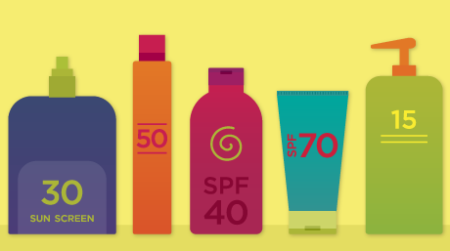If you are having fun in the sun without a stick, lotion or spray sunscreen, you are likely to get a sunburn. What people don’t realize is that you are also accelerating aging, increasing your risk for cancer and causing wrinkles.

This is why Dr. Lawrence Scherrer, Marshfield Clinic dermatologist, recommends making sunscreen a habit.
“You have to apply and reapply for the best sun protection,” said Dr. Scherrer. “Try various brands and formulations, and choose the one you don’t mind using because if you don’t like it, you won’t use it.”
Choosing the best sunscreen
When it comes to the best sunscreen for your face and body, Dr. Scherrer says it is most important to use a broad spectrum sunblock of 50 SPF or higher and then make sure you reapply it.
“I can’t stress this enough. The best thing you can do is find a sunscreen you like and get in the habit of applying it,” Scherrer said. “Once you’re in the habit of using it, you’ll start to feel naked when you forget to apply it.”
When it comes to the best sunscreen for your face, some prefer a stick or lotion for their face because spray sunblocks should not be inhaled and can get into your eyes. However, a sunscreen stick may be more difficult to apply to your entire body, which is why some feel spray or lotion sunscreens are the best body sunblocks.
As far as “chemical” versus “physical” and gels, lotions or sprays, the choice is yours. Chemical sunscreens contain special ingredients to reduce UV penetration to the skin. Physical sunscreens contain fine particles of titanium dioxide and zinc oxide to block UV radiation.
How to apply sunscreen
Each sunscreen is different, but here are some general rules for applying different types of sunscreens.
How to apply lotion sunscreen:
- Rub in 1 teaspoon per arm
- Rub in 2 teaspoons per leg, chest and back
- Reapply based on sunblock recommendations
How to apply spray sunscreen:
- Spray until your skin glistens
- Rub the sunblock in
- Reapply based on recommendations
How to apply a sunscreen stick:
- Apply four passes back and forth
- Rub the sunscreen in
- Reapply based on sunblock recommendations
Reapplying sunscreen
After you initially apply your sunscreen, it is important to reapply. Read individual directions for reapplication instructions.
“I like to use a cream or lotion in the morning before my hands and body are sweaty from the heat,” Scherrer said. “Then, reapply with a spray – something easier to use on-the-go.”
Waterproof and sweat-proof sunscreens also should be reapplied.
“Regardless of sunscreen claims, anything you apply in the morning will be gone by afternoon,” he said.
More sun-block tips
If you’re not a fan of sunscreen or need additional tips, consider:
- UPF clothing. Outdoor clothing with Ultraviolet Protection Factor (UPF) ratings are made to be breathable and cool. Sun protective clothing can be helpful for children who dislike topical lotions or adults with sensitive skin.
- Broad-brimmed hats are in. Grab a brimmed hat for sporting events or summer gatherings to create your own shade and sun protection.
- A protective pill. Though research is still being conducted, there are pills, like Heliocare®, with natural extracts to help skin protect itself. “I don’t recommend taking Heliocare® regularly,” he said, “but it’s a nice addition for a tropical trip or an extended sunny vacation.”
For sunburn concerns, talk to a Marshfield Clinic Health System provider.
Get care now Schedule appointment
More sun protection posts from Shine365:
Could my rash be a sun allergy?
Fun in the sun? Wrinkles, age spots for the long run
Holy moly: 5 signs of a melanoma mole
Is fair food healthy? It depends on the choice
Dehydration: Stay hydrated when in the heat
The power of pets: Your companion may be good for your health


Please try Bull-Frog Sunscreen, my kids hated it but it sticks like glue and gives you a ghostly appearance but it works great!